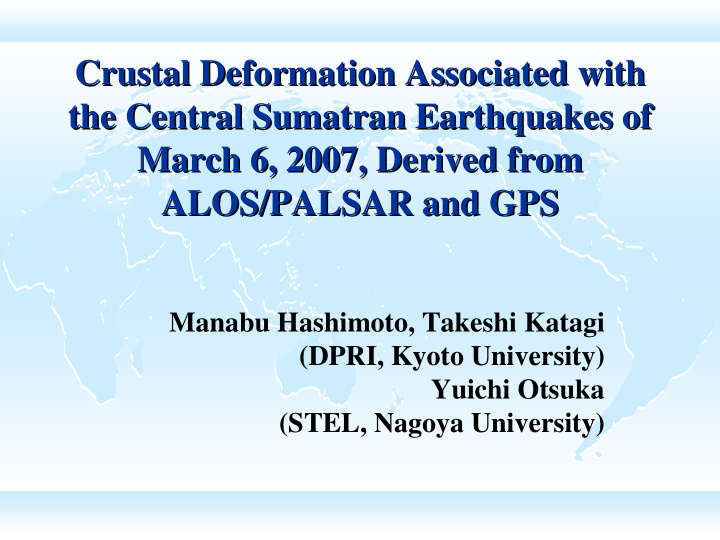



Crustal Deformation Associated with Crustal Deformation Associated with the Central Sumatran Earthquakes of the Central Sumatran Earthquakes of March 6, 2007, Derived from March 6, 2007, Derived from ALOS/PALSAR and GPS ALOS/PALSAR and GPS Manabu Hashimoto, Takeshi Katagi (DPRI, Kyoto University) Yuichi Otsuka (STEL, Nagoya University)
� PALSAR level 1.0 data are shared among PIXEL, and provided from JAXA under cooperative research contract with ERI, Univ. Tokyo. The ownership of PALSAR data belongs to METI (Ministry of Economy, Trade and Industry) and JAXA.
The Central Sumatra Earthquake The Central Sumatra Earthquake of March 6, 2007 of March 6, 2007 � Doublet of M6.4 and M6.3 � Epicenters are closely located to the Sumatra fault: A pull-apart basin � Focal mechanism of right lateral strike-slip � Surface ruptures
Where did they occur? Where did they occur? � Central Sumatra � Inland events on the Sumatra fault � Sumatra fault: right-lateral strike- slip fault accommodating oblique subdution � Volcanic chain
Past Past Seismicity Seismicity 2 2 0 0 0 0 7 7 ( Natawidjaja et al., 2007 )
Surface Ruptures due to the Doublet of 2007 2007 Surface Ruptures due to the Doublet of On the courtesy of Dr. Nakano Offset 22cm 2nd event Offset 24cm Ruptures the Sianok segment Surface rupture ( Natawidjaja et al., 2007 ) 1st event Ruptured the Sumani segment
On the courtesy of Dr. Danny Hilman Natawidjaja
CGPS observation in CGPS observation in SE Asia SE Asia � 11 sites in Thailand � 3 sites in Indonesia � 1 site each in Singapore and Myanmar � Complex tectonics – Oblique subduction – Back-arc spreading – Sumatra and Sagaing faults
Daily Coordinate Changes of the CGPS Sites in SE Asia Daily Coordinate Changes of the CGPS Sites in SE Asia (NS) (NS) Postseismic displacement following the Nias ITRF2000 event at PDNG?
Daily Coordinate Changes of the CGPS Sites in SE Asia Daily Coordinate Changes of the CGPS Sites in SE Asia (EW) (EW)
Coordinate Changes at Padang(PDNG Padang(PDNG) in 2007 ) in 2007 Coordinate Changes at ~3cm ~3cm ~1cm ~1cm
(USGS,2007) (USGS,2007) Close- -up of Central up of Central Close Sumatra Sumatra � Strike � Strike- -slip type slip type � NNW � NNW- -SSE trending SSE trending nodal plane is consistent nodal plane is consistent with the strike of Sumatra with the strike of Sumatra fault fault � Vertical nodal plane � Vertical nodal plane Area of ALOS/PALSAR Image
AlOS/PALSAR Images /PALSAR Images AlOS � Master: October 15, 2006 � Slave: June 6, 2007 � Descending orbit � B perp =1510m
Interferogram Interferogram � Fringe around the source area � Discontinuities parallel to the Sumatra fault � Low coherence in mountains
Interferogram Interferogram � Fringe around the source area � Discontinuities parallel to the Sumatra fault � Low coherence in mountains
Unwrapped Image (Preliminary) and GPS Displacement Unwrapped Image (Preliminary) and GPS Displacement
Unwrapped Image (Preliminary) and GPS Displacement Unwrapped Image (Preliminary) and GPS Displacement
Theoretical Displacements for Two Segment Model Theoretical Displacements for Two Segment Model No conjugate fault
Fault Parameters Fault Parameters δ φ λ L W H D Mo Mw (x10 18 (km) (km) (km) (deg) (deg) (deg) (m) Nm) 30 20 0.5 78 148 -175 0.4 7.2 6.5 35 20 0.5 78 148 -175 0.3 6.3 6.5
’ s According to the Matsuda ’ s According to the Matsuda ・・・ Formula ・・・ Formula = + (log 2 . 9 ) / 0 . 6 M L = / 10 D L � M=6.3~6.4 gives L=7.6~8.7km , D=0.8~0.9m. � The central Sumatra earthquake � Unusually long fault length � Inconsistent with the Matsuda’s formula � Significant slow slip? Surface creep?
Summary Summary � Discontinuities along the surface ruptures � Fault length ~ 65km � Fault length and slip are inconsistent with Matsuda ’ s formula � Possible creep? � No conjugate fault
Recommend
More recommend